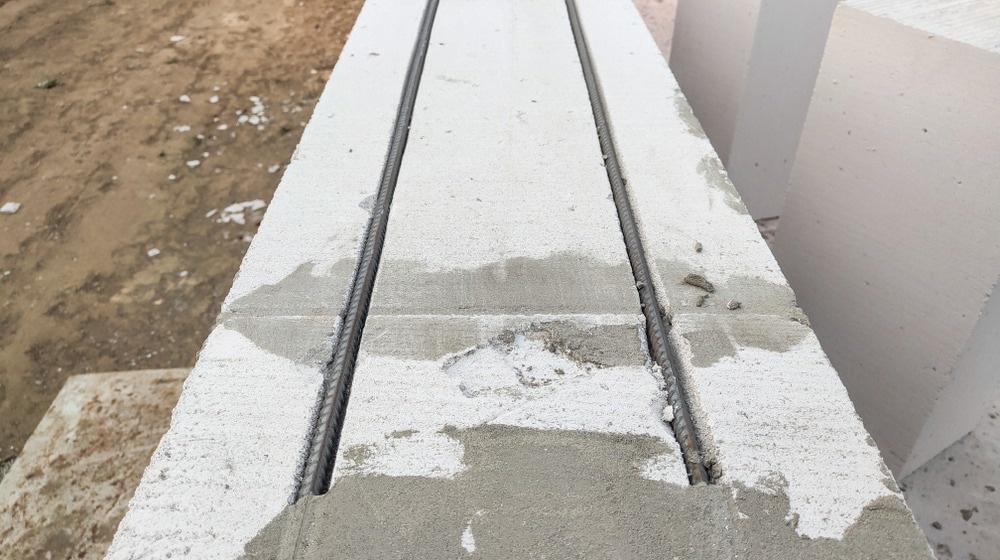Recently, there has been much conversation in the media about reinforced autoclaved aerated concrete (RAAC) due to its potential for failure over time. This article will provide an overview of this controversial building material.

Image Credit: Marykor/Shutterstock.com
Reinforced Autoclaved Aerated Concrete: Material Overview
RAAC gained popularity as a building material in the post-WW2 era in a wide range of municipal structures. Lightweight and inexpensive with good thermal properties, the material has been primarily used for roofing elements, floors, and walls as an alternative to traditional concrete.
The main difference between RAAC and traditional reinforced concrete is a lack of aggregate, which means that the structural behavior and mechanical properties of these concretes differ significantly.
RAAC is still used in buildings worldwide and, if properly manufactured and maintained, is an appropriate manufacturing material, providing an inexpensive and effective alternative to conventional reinforced concrete.
What are the Issues with RAAC?
Safety issues with RAAC building elements have been known about since the 1980s. Problems with rebar structural integrity were identified in RAAC panels installed during the 1960s and 1970s in public buildings such as schools and hospitals in the UK.
As the material ages, it can be subject to sudden failure due to issues such as water ingress and cracking and is less durable than traditional reinforced concrete. The lifetime of RAAC is around 30 years, meaning that structural engineers need to check buildings of this age for potential critical failures.
According to the Institute for Structural Engineers, RAAC’s strength can be reduced by around 13 percent due to short-term moisture exposure. Furthermore, air pollution can cause a 40 percent strength reduction over long periods of time.
As mentioned previously, RAAC is used in flat roofing panels, which can be hard to access, check, and maintain. Rainwater can weaken the material, leading to sudden, catastrophic, and potentially fatal structural collapse.
Being an aerated concrete, RAAC has “bubbles” throughout the material, which allow water ingress, increasing the risk of cracks and degradation. Additionally, flat roofing panels can sag, and if rainwater pools in these indentations, it can increase the risk of water entering the RAAC panels.
Poor construction in previous decades also adds to the problems faced by structural engineers currently. Recent reports have highlighted insufficient reinforcement quality, with problems such as supports that are too small, and wrongly placed steel reinforcement rebars.
What Can Be Done to Fix RAAC Panels?
Demolishing buildings affected by issues with RAAC panels would be prohibitively expensive and time-consuming, affecting the operation of municipal buildings. The Institute of Structural Engineers recommends at least five strategies to mitigate problems.
The first option is to use secondary supports and beams to improve bearing length. These are typically installed at the end bearing.
Secondly, positive remedial supports can be used to reduce loading on the panels. Lightweight materials such as timber can be used for direct panel support.
Thirdly, passive fail supports can be installed, mitigating potential structural issues in the event of RAAC panel failure. Secondary structures would help to avoid any risk to life if installed properly.
Finally, the removal of individual RAAC panels or the complete roof structure and replacement of the material with stronger, more durable concrete should be considered if support structures are insufficient and would not reduce the risk of further failure.
In Conclusion
RAAC has been used for decades in public buildings as it is cheap, lightweight, and fireproof. However, a lack of durability compared to other types of reinforced concrete has been identified since the 1980s, and RAAC is particularly vulnerable to water damage and cracking.
Whilst the problems with this type of concrete have been well-documented, the issues are mainly connected with RAAC panels installed in the 1960s and 1970s, poor construction, and maintenance in the intervening decades. If properly installed and maintained, RAAC can be an appropriate building material.
More from AZoBuild: What is Mycocrete?
Further Reading and More Information
Loughborough University (2023) Expert explainer: What is Reinforced Autoclaved Aerated Concrete (RAAC) and why are people concerned about it? [online] lboro.ac.uk. Available at:
https://www.lboro.ac.uk/news-events/news/2023/march/reinforced-autoclaved-aerated--concrete-raac/
McGuinness, R (2023) School concrete crisis: What methods will be used to fix crumbling Raac buildings? [online] uk.news.yahoo.com. Available at:
https://uk.news.yahoo.com/raac-crisis-fix-remove-engineers-concrete-schools-141712150.html?
Hassan, B.N (2023) What is RAAC and when was the concrete used to build schools? [online] standard.co.uk. Available at:
https://www.standard.co.uk/news/uk/what-raac-reinforced-autoclaved-aerated-concrete-schools-buildings-b1104629.html
Disclaimer: The views expressed here are those of the author expressed in their private capacity and do not necessarily represent the views of AZoM.com Limited T/A AZoNetwork the owner and operator of this website. This disclaimer forms part of the Terms and conditions of use of this website.